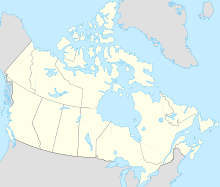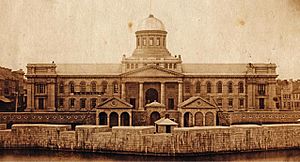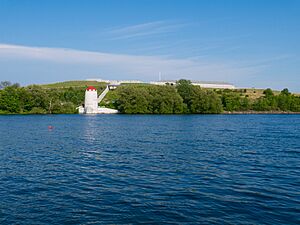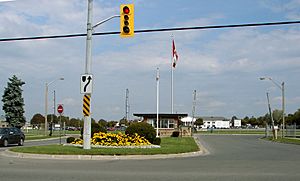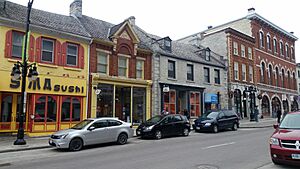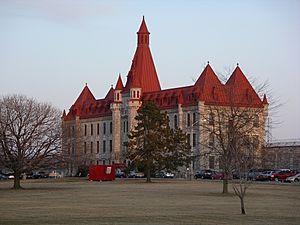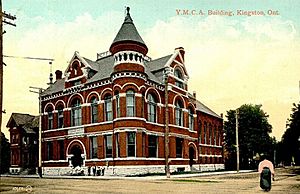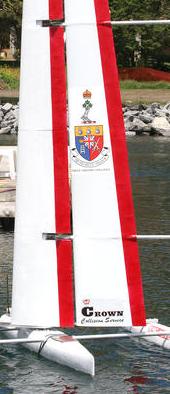Kingston, Ontario facts for kids
Quick facts for kids
Kingston
|
|||||
|---|---|---|---|---|---|
| City of Kingston | |||||
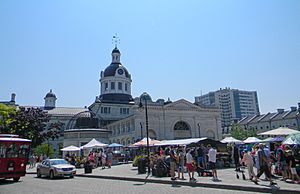
|
|||||
|
|||||
| Nickname(s):
"Limestone City"
|
|||||
| Motto(s):
Antiquitate Civilitate Humanitate (Latin)
("A Civil And Creative Community with a Proud Past") |
|||||
| Country | Canada | ||||
| Province | Ontario | ||||
| Established | 1673 (as Fort Cataraqui; later renamed Fort Frontenac) | ||||
| Incorporated | 1838 (as town); 1846 (as city) | ||||
| Amalgamated | 1998 (with Kingston and Pittsburgh Townships) | ||||
| Area | |||||
| • Land | 451.19 km2 (174.21 sq mi) | ||||
| • Metro | 1,906.82 km2 (736.23 sq mi) | ||||
| Elevation | 93 m (305 ft) | ||||
| Population
(2021)
|
|||||
| • City (single-tier) | 132,485 | ||||
| • Density | 274.4/km2 (711/sq mi) | ||||
| • Metro | 172,546 | ||||
| • Metro density | 83.1/km2 (215/sq mi) | ||||
| source: | |||||
| Time zone | UTC– 05:00 (EST) | ||||
| • Summer (DST) | UTC– 04:00 (EDT) | ||||
| Postal code span |
K7K through K7P
|
||||
| Area code(s) | Area codes 613, 343, and 753 | ||||
| GDP (Kingston CMA) | CA$ 9.4 billion (2018) | ||||
| GDP per capita (Kingston CMA) | CA$54,022 (2016) | ||||
| Website | www.cityofkingston.ca | ||||
Kingston is a city in Ontario, Canada, located on the northeastern shore of Lake Ontario. It sits where the St. Lawrence River begins and the Cataraqui River (the southern end of the Rideau Canal) joins the lake. Kingston is close to the Thousand Islands, a popular tourist area to the east, and the Prince Edward County tourist region to the west. People often call Kingston the "Limestone City" because many of its old buildings are made from local limestone.
European explorers arrived in the 1600s. They wanted to trade with local Indigenous people and control the fur trade. This led to the French building a trading post and military fort called "Cataraqui" in 1673. This outpost, later known as Fort Frontenac, grew into a settlement. After the British took over in the 1700s, Cataraqui was renamed Kingston. Loyalists, who were British supporters fleeing the American Revolution, started settling here in the 1780s.
Kingston was chosen as the first capital of the United Province of Canada on February 10, 1841. Even though it was capital for only a short time (until 1844), it has remained an important military location. Today, Kingston is a key center for education and health care. It has a major university, a large college, and three main hospitals.
Kingston was the main town of Frontenac County until 1998. Now, Kingston is its own separate city. It is the largest city in southeastern Ontario and the 10th largest metropolitan area in Ontario. John A. Macdonald, Canada's first Prime Minister, lived in Kingston.
Contents
- Exploring Kingston's Past
- Kingston's Military History
- Historic Sites in Kingston
- Kingston's Population and People
- Kingston's Economy
- Getting Around Kingston
- Kingston's Culture and Arts
- Learning in Kingston
- Prisons and Correctional Facilities
- Kingston's Geography and Weather
- Sports in Kingston
- Notable People from Kingston
- Images for kids
- See also
Exploring Kingston's Past
How Kingston Got Its Name
Kingston's first name was Cataraqui. This name comes from an Indigenous word for the area. It might mean "Great Meeting Place," "the place where one hides," or "where the rivers and lake meet."
By 1787, people started calling Cataraqui "the King's Town" or "King's Town" to honor King George III. This name was shortened to "Kingston" in 1788. Today, Cataraqui refers to an area in Kingston and also a local voting district.
Early Indigenous Life in Kingston
Scientists have found signs that people lived in the Kingston area as far back as 9,000 to 3,000 years ago. There is also proof of early Iroquois people living here around 500 to 1000 AD. The first lasting camps by Indigenous people in Kingston began around 900 AD. The Wyandot people (Hurons) likely lived here before the French arrived. Later, Five Nations Iroquois (Haudenosaunee) settled along Lake Ontario's north shore.
By 1700, the Iroquois moved south. The Mississaugas, a group of Anishinaabe people, then moved into the area, including Kingston.
French Settlement and Fort Frontenac
In the 1600s, the fur trade became very important in North America. French trappers and traders spread out from their bases in New France. French explorer Samuel de Champlain visited the Kingston area in 1615.
To control the fur trade with local Indigenous people, Louis de Buade de Frontenac, the Governor of New France, built Fort Cataraqui in 1673. This fort was later called Fort Frontenac. It was a trading post and military base, attracting both Indigenous and European settlers. In 1674, René-Robert Cavelier, Sieur de La Salle took charge of the fort. From here, de La Salle explored far to the west and south.
The fort was rebuilt many times and sometimes left empty. The Iroquois attacked it in 1688, causing many deaths. The French then destroyed the fort but later rebuilt it. The British destroyed it again in 1758 during the Seven Years' War. Its ruins were left until the British took over and partly rebuilt it in 1783. The fort was renamed Tête-de-Pont Barracks in 1787. It became part of the Canadian military in 1870–71 and is still used by them today. It was renamed Fort Frontenac in 1939. You can still see parts of the original fort near the La Salle Causeway.
Loyalist Settlement in Kingston
In 1783, Frederick Haldimand, the governor of Quebec, asked Major Samuel Holland to plan a new settlement. This settlement was for Loyalists, who were British colonists leaving the United States after the American Revolutionary War. Holland's report said the old French fort area was excellent, with a good harbor.
To help with settlement, the British Crown bought land from the Mississaugas in October 1783. This agreement, called the Crawford Purchase, opened up much of Lake Ontario's north shore for settlement. The area was surveyed and found to have good land, many resources, and a great harbor. These things made it perfect for Loyalists. Many Loyalists who had settled on Carleton Island moved to Cataraqui when the island became part of the United States.
Important Loyalists who settled here included Molly Brant, a leader's sister, and Richard Cartwright, a businessman. John Stuart, a clergyman and teacher, arrived in 1785. A group led by Captain Michael Grass arrived in 1784 and set up a camp. The Loyalists first called the settlement King's Town, which later became Kingston.
The first high school in what is now Ontario was started in Kingston in 1792 by John Stuart. This school later became Kingston Collegiate and Vocational Institute.
War of 1812 and City Growth
During the War of 1812, Kingston was a major military hub with about 2,250 people. It was the main base for the British naval fleet on Lake Ontario. The British and American fleets were in a race to build more warships. Fortifications were built to protect the town and the dockyards. The first Fort Henry was built then. A larger fort was built in 1813.
The current stone Fort Henry was built between 1832 and 1836. It was meant to protect the new Rideau Canal, the harbor, and the naval dockyard. Fort Henry was used by the British until 1871. It was restored in 1936 and is now a popular tourist spot and a World Heritage Site.
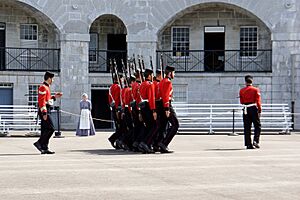
Kingston's location at the start of the Rideau Canal made it a key military and economic center after the canal opened in 1832. It became a town in 1838, and Thomas Kirkpatrick was its first mayor. Kingston was the largest town in Upper Canada until the 1840s. It became a city in 1846.
Kingston became an important port for shipping goods. Products like wheat and meat from the west were unloaded here. They were then transferred to smaller boats that could travel the St. Lawrence River. The Rideau Canal offered a safer way to move goods, especially lumber.
Regiopolis College, a school for training priests, opened in 1837. Queen's University, one of Canada's first universities, started classes in 1842. It was founded by the Presbyterian Church. The Royal Military College of Canada (RMC) was founded in 1876.
Kingston Penitentiary, Canada's first large federal prison, opened in 1835 and closed in 2013. Other prisons were built later in the Kingston area.
Kingston as Canada's First Capital
Lord Sydenham chose Kingston as the first capital of the united Canadas. It was the capital from 1841 to 1844. The first Parliament meeting was held in Kingston on June 13, 1841. However, the city was thought to be too small and too close to the U.S. border for safety. So, the capital moved to Montreal in 1844. It then moved between Quebec City and Toronto until Ottawa was chosen as the permanent capital by Queen Victoria. After this, Kingston's growth slowed.
In 1846, Kingston had 6,123 people and became a city. John Counter was the first mayor. The market house was a famous building, holding offices, the post office, and City Hall (finished in 1844). Five newspapers were published. Kingston Penitentiary had about 400 prisoners. Industries included a mill, foundries, and shipbuilders. All goods were shipped by boat. The city had schools and bank offices. There were ten churches and the Hotel Dieu hospital, run by nuns, had just opened.
Both Hotel Dieu and Kingston General Hospital (KGH) helped people during the typhus outbreak of 1847. Many Irish immigrants who died from typhus were buried at KGH. Their remains were moved to St. Mary's Cemetery in 1966. In 1995, KGH was named a National Historic Site of Canada because it is Canada's oldest public hospital still running.
In 1848, the Kingston Gas Light Company started. Gas lamps were used until 1947. By then, the city was connected by telegraph.
The Grand Trunk Railway arrived in Kingston in 1856. It connected Kingston to Toronto and Montreal. Kingston became an important railway center for both people and goods.
By 1869, the population was 15,000. There were two shipbuilding yards.
Kingston was the home of Canada's first Prime Minister, John A. Macdonald. He was first elected to Kingston City Council in 1843. He represented the city for almost 50 years at the national level. One of his homes, Bellevue House, is now a National Historic Site open to the public. It shows how the house looked when he lived there in the 1840s.
On April 18, 1840, a large fire started at the docks. Strong winds spread it to a warehouse with gunpowder. The explosion caused the fire to destroy many buildings downtown, including the old city hall. To prevent this from happening again, the city started building with limestone or brick. This rebuilding was called "the Limestone Revolution," giving Kingston its nickname, "The Limestone City."
Kingston in the 1900s
In the early 1900s, the Canadian Locomotive Company was the largest locomotive factory in the British Empire. The Davis Tannery was once the largest tannery in the British Empire. It closed in 1973. Other factories built steamboats, made iron, and produced soap. By the 2000s, most heavy industries left the city.
A telephone system started in Kingston in 1881. At that time, the population was 14,091. Electricity came to Kingston in 1888.
Kingston grew steadily through the 1900s. In 1952, the city added about 5,500 acres of land. This included areas west to the Little Cataraqui Creek, where many new homes were built in the 1950s and 60s.
After World War II, Kingston's economy changed. It moved from industry to institutions. Queen's University grew from 2,000 students in the 1940s to over 28,000 today. Most students come from outside Kingston. The Kingston campus of St. Lawrence College opened in 1969 and has 6,700 full-time students. The Royal Military College of Canada, founded in 1876, has about 1,000 students. Kingston is also a regional health care center, with Kingston General Hospital and Queen's medical school. The city's economy is now mainly based on education, military, and prisons.
In 1998, the city of Kingston joined with Kingston Township and Pittsburgh Township. This created the new City of Kingston. The city's borders now include large rural areas north of Highway 401 and east of the Cataraqui River.
Kingston in the 2000s
The La Salle Causeway bridge, which crosses the Cataraqui River near downtown and Fort Henry, was taken down by the Government of Canada in 2024. This happened after a mistake during repair work caused it to collapse.
Kingston's Military History
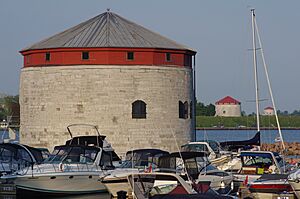
Kingston has always been important for military reasons. It is located at the top of the St. Lawrence River and the mouth of the Cataraqui River, near the U.S. border. Fort Frontenac was built here in 1673. Both the French and British had military bases here. The War of 1812 led to more troops, ship repairs, and new forts to protect the town and the Naval Dockyard. Forts were built on Point Henry and Point Frederick. A wooden wall with five blockhouses was built west of the town. In November 1812, American ships attacked the British ship Royal George in Kingston harbor.
Several forts were built in the late 1840s because of tensions with the United States. These include Fort Henry, four Martello towers (Cathcart Tower, Shoal Tower, Murney Tower, and Fort Frederick), and the Market Battery. Military ships were built at the Naval Dockyard from 1788 to 1853. The area near the Royal Military College of Canada was the main base for the Royal Navy from 1813 to 1853.
After the British army left most of Canada in 1870–71, Canada formed two artillery batteries. The "A" Battery was in Kingston at Fort Henry and Tête du Pont Barracks (Fort Frontenac). These batteries also served as gunnery schools. This group became the Royal Canadian Horse Artillery.
The Canadian government realized it needed a college to train military officers. In 1874, a law was passed to create one. Point Frederick, where the old naval dockyard was, was chosen for Canada's first military college. This was because of Kingston's military history and existing buildings.
Before the college opened in 1876, there were military schools. In 1865, a School of Military Instruction in Kingston taught militia officers about military duties. This school continued after Canada became a country in 1867.
The Royal Military College of Canada (RMC) opened on Point Frederick in 1876 with 18 students. It provided both academic and military training. In 1959, it became the first military college in the Commonwealth that could give university degrees.
East of downtown Kingston, the army's Camp Barriefield was built at the start of World War I. It was expanded during World War II. It is now called McNaughton Barracks. Nearby Vimy Barracks was built in 1937 for military communications training. McNaughton and Vimy Barracks make up most of Canadian Forces Base Kingston (CFB Kingston). Other military sites supported by CFB Kingston include Fort Frontenac and the Royal Military College of Canada.
The Princess of Wales' Own Regiment has been in Kingston since 1863. It is a reserve regiment, with members from Kingston and the surrounding area.
During World War I, the 21st Battalion was formed and fought in France. Fort Henry became a camp for enemy aliens from 1914 to 1917.
During World War II, the Stormont, Dundas and Glengarry Highlanders (SD&G) were formed in June 1940. Fort Henry was again an internment camp from 1939 to 1943. A military airport, RCAF Station Kingston, was built west of Kingston for flying training.
Historic Sites in Kingston
Kingston is famous for its historic buildings and places. The city's motto, "where history and innovation thrive," shows this. Kingston has 1211 properties listed in its heritage register. These include World Heritage Sites, National Historic Sites, and other important heritage properties.
In 2007, the Rideau Canal and the forts in Kingston were named a World Heritage Site. This is one of only 15 such sites in Canada.
Kingston has 21 National Historic Sites of Canada.
Kingston's Population and People
| Historical populations | ||
|---|---|---|
| Year | Pop. | ±% |
| 1871 | 12,407 | — |
| 1881 | 14,091 | +13.6% |
| 1891 | 19,263 | +36.7% |
| 1901 | 17,961 | −6.8% |
| 1911 | 18,874 | +5.1% |
| 1921 | 21,753 | +15.3% |
| 1931 | 23,439 | +7.8% |
| 1941 | 30,126 | +28.5% |
| 1951 | 33,459 | +11.1% |
| 1956 | 48,618 | +45.3% |
| 1961 | 53,526 | +10.1% |
| 1966 | 59,004 | +10.2% |
| 1971 | 59,047 | +0.1% |
| 1976 | 56,032 | −5.1% |
| 1981 | 52,616 | −6.1% |
| 1986 | 55,050 | +4.6% |
| 1991 | 56,597 | +2.8% |
| 1996 | 55,947 | −1.1% |
| 2001 | 114,195 | +104.1% |
| 2006 | 117,207 | +2.6% |
| 2011 | 123,363 | +5.3% |
| 2016 | 123,798 | +0.4% |
| 2021 | 132,485 | +7.0% |
In 2021, Kingston had a population of 132,485 people. This was a 7% increase from 2016. The Kingston metropolitan area had a population of 172,546 people in 2021.
Who Lives in Kingston?
In 2021, most Kingston residents (82.4%) were white or European. About 13.4% were from visible minorities, and 4.2% were Indigenous. The largest visible minority groups were South Asian (3.4%), Chinese (2.4%), and Black (2.0%).
Many people in Kingston have Irish (25.9%), English (25.5%), or Scottish (20.0%) backgrounds. About 16.3% identify as Canadian.
Religion in Kingston

In 2021, about half of Kingston's population (65,490 people) were Christian. The largest Christian groups were Roman Catholics (23.5%), the United Church of Canada (6.6%), and the Anglican Church of Canada (6.7%).
The Presbyterian Church was very important in Kingston's education in the 1800s. It helped start and fund Queen's University until 1912. John A. Macdonald was also a member of St. Andrew's Presbyterian Church.
Kingston's downtown has many large stone churches, showing its religious history. Some of these old churches are now used as community spaces.
Other religious groups include Muslims (2.6%), Hindus (1.3%), and Jews (0.7%). About 42.9% of the population said they were not religious.
Kingston's Economy
Kingston's economy mostly depends on public services. The most important areas are health care, higher education (Queen's University, Royal Military College, St. Lawrence College), and government (military and prisons). Tourism and culture are also important. Manufacturing and research and development are less important than they used to be.
The private sector provides half of Kingston's jobs. Big industrial employers like the Canadian Locomotive Company closed in 1969. Former Alcan and DuPont factories now employ fewer people. However, because Kingston is located between Toronto, Ottawa, Montreal, and Syracuse, NY, a trucking and warehousing industry has grown.
Major employers in Kingston include Queen's University, Canadian Forces Base Kingston, and Kingston Health Sciences Centre.
Tourism in Kingston
Tourism is a very important part of Kingston's economy. In 2004, tourism created over 3,500 jobs in the city. The tourism industry has been growing well.
Kingston has launched campaigns to attract more visitors. "Downtown Kingston!" promotes the downtown area as a lively center for shopping, living, and entertainment. The downtown hosts events like the Kingston Buskers Rendezvous and the Limestone City Blues Festival.
Another campaign, "Yellow Door," promotes tourism to the whole city. It uses a yellow door as a symbol for Kingston and the fun times people have there. This campaign has won awards for promoting Ontario tourism.
Fun Places to Visit in Kingston
According to TripAdvisor, some of the best attractions in Kingston are Canada's Penitentiary Museum, Fort Henry, Wolfe Island (reached by ferry), Bellevue House National Historic Site, and the City Hall waterfront. Ontario Travel suggests cruising the Thousand Islands, visiting The Grand Theatre, and going to Slush Puppie Place.
Getting Around Kingston
Highway 401 is the main road into Kingston. It runs across the northern part of the city. The first parts of the highway in Kingston opened in 1958. The Waaban Crossing and the La Salle Causeway are bridges over the Cataraqui River. Highway 15 is another way to get between Kingston and the Ottawa area. From the south, Interstate 81 connects to Highway 401 east of Kingston.
Ferry Services
A regular ferry runs between downtown Kingston and Wolfe Island. In summer, a ferry from Cape Vincent, New York, also goes through Wolfe Island to downtown Kingston. There are also tourist ferries that leave downtown Kingston often, especially in summer.
Train Travel (Via Rail)
Via Rail trains connect Kingston along the main line between Windsor and Quebec City. Kingston is a regular stop for trains going between Toronto and Ottawa, and Toronto and Montreal.
Bus Travel
Megabus offers frequent bus service from Kingston to many places in Ontario and Quebec. You can take direct buses to Toronto, Montreal, Ottawa, and other cities.
In 2021, Rider Express started serving Kingston on its Toronto-Ottawa route. This gives direct bus service to Toronto, Ottawa, and Belleville.
In 2022, FlixBus also started serving Kingston on its Windsor-Ottawa route. This connects Kingston to Toronto, Ottawa, Hamilton, and other cities.
Local Buses (Kingston Transit)
Kingston Transit manages the local bus system in Kingston. It has over 20 bus routes. More routes are added seasonally for students. The standard fare is $3.25 for riders over 15. Children under 15 ride for free.
Kingston Access Services provides bus service for residents with disabilities who cannot use regular Kingston Transit.
Taxi Services
Two taxi companies operate in Kingston: Amey's Taxi and Modern City Taxi Cab Limited. Uber also offers services in the city.
Kingston's Culture and Arts
Kingston hosts many festivals throughout the year. These include the Kingston WritersFest, Limestone City Blues Festival, and the Kingston Canadian Film Festival. Other popular events are Artfest, the Kingston Buskers Rendezvous, and the Wolfe Island Music Festival.
Kingston is home to many artists. They work in visual arts, media arts, and literature. The city has two main art venues: the Agnes Etherington Art Centre (started in 1957) and Modern Fuel Artist-Run Centre (started in 1977). These places show art from local artists and artists from across Canada and the world.
The Kingston WritersFest happens every year. The Ukrainian Canadian Club of Kingston hosts the "Lviv, Ukraine" pavilion each June, celebrating Ukrainian culture. Literary events also take place at the Kingston Frontenac Public Library and local bookstores. Many writers have lived in Kingston, including Steven Heighton, Bronwen Wallace, and Helen Humphreys.
Music and theater venues include the Isabel Bader Centre for the Performing Arts and The Grand Theatre. These host shows by international, national, and local groups. The Kingston Symphony performs at The Grand Theatre. The Kick & Push Festival started in 2015 to offer more summer theater. Slush Puppie Place, a large entertainment venue and ice rink, opened in 2008.
Many musicians and bands have come from Kingston. Some are famous mainly in Canada, while others have found international success. These include The Tragically Hip, Steppenwolf frontman John Kay, and The Glorious Sons.
Kingston is also the birthplace of Bryan Adams. Ryan Malcolm, the first winner of Canadian Idol, is from Kingston.
Comedian and actor Dan Aykroyd lives north of Kingston and is often seen in town.
Learning in Kingston
Kingston has two universities: Queen's University and the Royal Military College of Canada. It also has a community college, St. Lawrence College. Kingston has the most people with PhDs per person of any city in Canada.
Queen's University
Queen's University is one of Ontario's oldest universities. It offers many different degree programs. The university was started in 1841 by Queen Victoria. It has over 31,000 students. Queen's main campus is close to downtown Kingston, making it easy for students and staff to walk around.
Royal Military College of Canada
The Royal Military College of Canada (RMC), founded in 1876, is Canada's only military university. It trains officer cadets and other members of Canada's armed forces. It also accepts civilians. RMC has 1,100 undergraduate students and 500 graduate students.
St. Lawrence College
St. Lawrence College offers bachelor's degree programs at its Kingston campus. These include behavioral psychology, nursing, and business administration. It also offers certificate and diploma programs.
Schools for Kids in Kingston
The Limestone District School Board serves students in Kingston and nearby counties. About 21,000 students attend 70 elementary and secondary schools in this board. The Algonquin and Lakeshore Catholic District School Board serves Roman Catholic students. About 12,800 students attend 36 elementary and five secondary schools in this district. Catholic high schools in Kingston include Regiopolis Notre-Dame and Holy Cross Catholic High School. French-speaking students are served by two school boards, each with one secondary school in the area.
Here are the secondary schools in Kingston:
- Bayridge Secondary School
- École secondaire catholique Marie-Rivier
- École secondaire publique Mille-Îles
- Frontenac Secondary School
- Holy Cross Catholic Secondary School
- Kingston Secondary School
- La Salle Secondary School
- Leahurst College High School
- Loyalist Collegiate and Vocational Institute
- Regiopolis-Notre Dame Catholic Secondary School
Prisons and Correctional Facilities
Kingston has the largest number of federal prisons in Canada. The Correctional Service of Canada runs these facilities. Seven of the nine institutions in the Kingston area are within the city limits.
- Kingston Penitentiary (maximum security) (Officially closed September 30, 2013).
- Regional Treatment Centre (various security levels), located inside Kingston Penitentiary.
- Joyceville Institution (medium security).
- Pittsburgh Institution (minimum security), located with Joyceville.
- Collins Bay Institution (medium security).
- Frontenac Institution (minimum security), located with Collins Bay.
Until 2000, Canada's only federal prison for women, the Prison for Women (also called "P4W"), was also in Kingston. It closed in 2000. Queen's University bought the property.
In September 2013, Kingston Penitentiary closed after almost 180 years. This maximum-security prison was named a National Historic Site of Canada in 1990. In its early years, the prison helped build the city and its economy.
Kingston's Geography and Weather
Kingston is in the Mixedwood Plains Ecozone. This area has many different types of trees and lots of water. The ground is mostly made of Ordovician limestone.
Kingston has a moderate humid continental climate. It has cooler summers and colder winters than most of Southern Ontario. Being close to Lake Ontario makes the weather milder. But it can also bring more rain or heavy snow. Strong winds often blow off Lake Ontario, making Kingston one of Canada's windiest cities, especially near the water. The highest temperature ever recorded was 35.6°C on July 9, 1936. The coldest was -35.6°C on February 17, 1896.
The main part of the city is between the Cataraqui River to the east and the Little Cataraqui Creek to the west. The eastern part of the city can be reached by the La Salle Causeway on Highway 2.
Important parts of Kingston's waterfront include Flora MacDonald Confederation Basin, Portsmouth Olympic Harbour, Collins Bay, Wolfe Island, and the Cataraqui River.
| Climate data for Kingston, 1991-2020 normals (Average Temperature) 1981–2010 normals, extremes 1872–present | |||||||||||||
|---|---|---|---|---|---|---|---|---|---|---|---|---|---|
| Month | Jan | Feb | Mar | Apr | May | Jun | Jul | Aug | Sep | Oct | Nov | Dec | Year |
| Record high °C (°F) | 13.5 (56.3) |
14.4 (57.9) |
24.0 (75.2) |
30.7 (87.3) |
31.7 (89.1) |
35.0 (95.0) |
35.6 (96.1) |
34.5 (94.1) |
33.3 (91.9) |
25.1 (77.2) |
21.1 (70.0) |
16.1 (61.0) |
35.6 (96.1) |
| Mean daily maximum °C (°F) | −2.6 (27.3) |
−1.8 (28.8) |
3.2 (37.8) |
10.0 (50.0) |
17.6 (63.7) |
22.1 (71.8) |
25.4 (77.7) |
24.6 (76.3) |
20.5 (68.9) |
13.8 (56.8) |
7.5 (45.5) |
1.6 (34.9) |
11.8 (53.2) |
| Daily mean °C (°F) | −7 (19) |
−6.3 (20.7) |
−1.1 (30.0) |
5.4 (41.7) |
12.4 (54.3) |
17.3 (63.1) |
20.8 (69.4) |
20.4 (68.7) |
15.6 (60.1) |
9.5 (49.1) |
3.5 (38.3) |
−2.2 (28.0) |
7.3 (45.1) |
| Mean daily minimum °C (°F) | −11.5 (11.3) |
−10.9 (12.4) |
−5.5 (22.1) |
0.9 (33.6) |
7.3 (45.1) |
12.5 (54.5) |
16.1 (61.0) |
15.3 (59.5) |
10.7 (51.3) |
5.1 (41.2) |
−0.6 (30.9) |
−6 (21) |
2.8 (37.0) |
| Record low °C (°F) | −34.5 (−30.1) |
−35.6 (−32.1) |
−27.8 (−18.0) |
−17.2 (1.0) |
−6.1 (21.0) |
0.6 (33.1) |
6.0 (42.8) |
3.3 (37.9) |
−1.7 (28.9) |
−7.5 (18.5) |
−25.6 (−14.1) |
−34.4 (−29.9) |
−35.6 (−32.1) |
| Average precipitation mm (inches) | 65.2 (2.57) |
65.1 (2.56) |
69.2 (2.72) |
87.1 (3.43) |
76.9 (3.03) |
72.0 (2.83) |
64.0 (2.52) |
93.7 (3.69) |
89.7 (3.53) |
92.4 (3.64) |
100.3 (3.95) |
84.1 (3.31) |
959.6 (37.78) |
| Average rainfall mm (inches) | 29.2 (1.15) |
29.0 (1.14) |
41.3 (1.63) |
77.5 (3.05) |
76.9 (3.03) |
72.0 (2.83) |
64.0 (2.52) |
93.7 (3.69) |
89.7 (3.53) |
91.0 (3.58) |
92.4 (3.64) |
52.2 (2.06) |
808.7 (31.84) |
| Average snowfall cm (inches) | 39.5 (15.6) |
39.1 (15.4) |
25.4 (10.0) |
8.1 (3.2) |
0.0 (0.0) |
0.0 (0.0) |
0.0 (0.0) |
0.0 (0.0) |
0.0 (0.0) |
1.2 (0.5) |
8.0 (3.1) |
35.9 (14.1) |
157.1 (61.9) |
| Average precipitation days (≥ 0.2 mm) | 16.1 | 13.9 | 12.8 | 13.5 | 12.9 | 11.4 | 9.3 | 11.1 | 12.3 | 13.7 | 16.2 | 15.8 | 159.1 |
| Average rainy days (≥ 0.2 mm) | 5.4 | 5.1 | 8.2 | 11.9 | 12.9 | 11.4 | 9.3 | 11.1 | 12.3 | 13.6 | 14.0 | 8.1 | 123.4 |
| Average snowy days (≥ 0.2 cm) | 13.2 | 11.1 | 7.3 | 2.6 | 0.0 | 0.0 | 0.0 | 0.0 | 0.0 | 0.40 | 4.3 | 11.5 | 50.4 |
| Mean monthly sunshine hours | 93.2 | 113.1 | 144.2 | 161.8 | 218.0 | 243.7 | 279.3 | 238.7 | 164.4 | 139.7 | 89.5 | 73.1 | 1,958.8 |
| Percent possible sunshine | 32.4 | 38.5 | 39.1 | 40.2 | 47.7 | 52.6 | 56.5 | 55.0 | 43.7 | 40.9 | 30.9 | 26.4 | 42.2 |
| Source: Environment Canada | |||||||||||||
Sports in Kingston
Ice Hockey in Kingston
Kingston is often called the birthplace of ice hockey, though others also claim this title. A British Army officer in Kingston wrote in his journal in 1843: "Began to skate this year, improved quickly and had great fun at hockey on the ice." Kingston also has the oldest continuous hockey rivalry in the world. This started with a game in 1886 on the frozen Kingston harbor between Queen's University and the Royal Military College of Canada. To celebrate this, the city holds an annual game between the two schools on the frozen lake. The teams wear old uniforms and use rules from that time.
The Memorial Cup, the annual championship for the Canadian Hockey League, started in 1919 because of Kingstonian James T. Sutherland. The first championship was held in Kingston. Sutherland, a member of the Hockey Hall of Fame, also helped start the yearly game between the Royal Military College of Canada and the United States Military Academy (West Point) in 1923.
Kingston has a team in the Ontario Hockey League (OHL) called the Kingston Frontenacs.
The International Hockey Hall of Fame was founded in September 1943. Its original building was near the Kingston Memorial Centre. It has since moved to the Invista Centre in Kingston's west end. This Hall of Fame, started by the National Hockey League (NHL), is Canada's oldest sports hall of fame. The museum has many items showing Kingston's role in hockey history. These include the original square hockey puck from the first Queen's vs. RMC game in 1886.
Slush Puppie Place, in downtown Kingston, opened in February 2008. It is the home ice for the Frontenacs.
Sailing in Kingston
Kingston is known for its fresh-water sailing. It hosted the sailing events for the 1976 Summer Olympics. CORK – Canadian Olympic-training Regatta, Kingston – is still held every August. Since 1972, Kingston has hosted over 40 World and Olympic sailing championships. Experts list Kingston as one of the best places for yacht racing in the U.S., even though it's in Canada.
Kingston is great for cruising and boating. It has easy access to Lake Ontario, the St. Lawrence River, and the Thousand Islands, including the St. Lawrence Islands National Park.
Kingston is also home to the youth sail training ship called the St. Lawrence II.
In the summers, the RMC campus hosts a Royal Canadian Sea Cadets camp called HMCS Ontario. It teaches sailing and other skills to young people from across Canada. The Kingston Yacht Club in downtown Kingston has sailing programs for children and adults.
Diving in Kingston
Kingston is known for fresh-water wreck diving. The shipwrecks here are well preserved by the cool, fresh water. The recent invasion of zebra mussels has made the water much clearer, which improves diving in the area.
Lawn Bowling
The Kingston Lawn Bowling Club has been on Napier Street since 1932. The sport started in Kingston around 1914. Many club members have competed successfully at provincial levels. Dick Edney, a notable member, was inducted into the Kingston and District Sports Hall of Fame in 2005.
Golf
The Kingston area has eight golf courses. The Kingston Golf Club, started in 1884, was a founding member of the Royal Canadian Golf Association. The first winner of the Canadian Amateur Championship was Kingstonian Thomas Harley. Richard H. (Dick) Green, a long-time professional at Cataraqui Golf and Country Club, helped design several courses in eastern Ontario. Matt McQuillan, a professional golfer, was born and raised in Kingston.
Curling
Kingston has three curling clubs: Cataraqui Golf & Country Club, Garrison Golf & Curling Club, and the Royal Kingston Curling Club. The Royal Kingston Curling Club (RKCC) was founded in 1820.
Kingston has hosted major curling events. In 2020, Kingston hosted the Tim Hortons Brier, the national men's curling championship. It also hosted the Scotties Tournament of Hearts, the national women's curling championship, in 2013.
Rugby
The Kingston Panthers Rugby Football Club (KPRFC) was founded in 1959. It is a non-profit organization. The Panthers recently won an EORU championship.
Football
The earliest known football team in Kingston was the Kingston Granites. They played in a league that came before the Canadian Football League. The team won a championship in 1899. Kingston also hosted the 10th Grey Cup in 1922. The Limestone Grenadiers now represent Kingston in the OVFL. Many famous football players and coaches have been connected to Kingston.
Volleyball
The Kingston Volleyball Club (KVC) was founded in 2015. It is a non-profit organization and a member of the Ontario Volleyball Association (OVA). The club relies on fundraising to operate.
Notable People from Kingston
Images for kids
See also
 In Spanish: Kingston (Ontario) para niños
In Spanish: Kingston (Ontario) para niños






